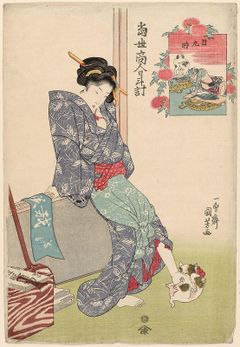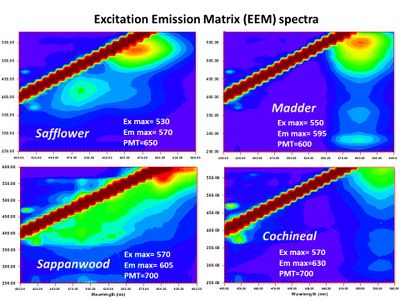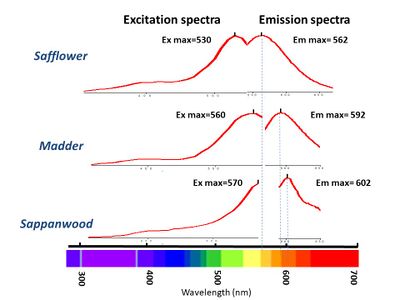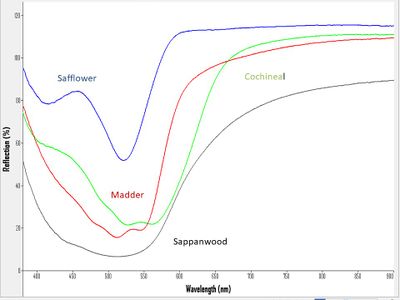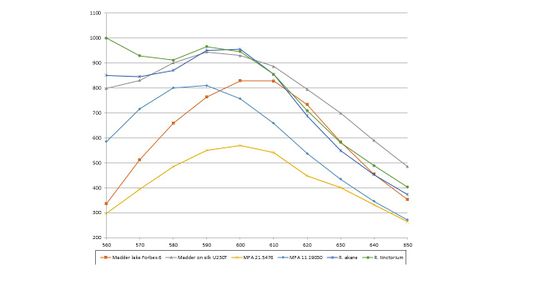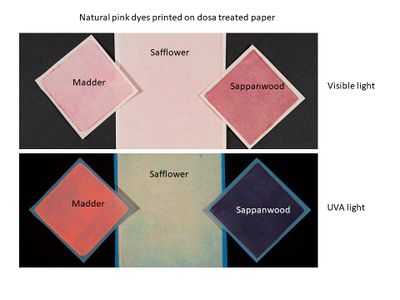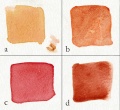Difference between revisions of "Category:Madder: Ukiyo-e colorant"
| Line 1: | Line 1: | ||
| − | [[File: | + | [[File:SC169506.jpg|right|240px|link=Kuniyoshi, The Ninth Hour: Noon; Woman Playing with Cat, Fishmonger and Dog, from the series Sundial of Modern Tradesmen, 11.15955|The Ninth Hour... by Utagawa Kuniyoshi]] |
<font size="3">'''[[Madder]]'''</font> 茜(''akane''): A red dye extracted from the roots of any of several species of the genus ''Rubia''. The most commonly used plants include: ''Rubia tinctorum'' L., native to the Middle East and eastern Mediterranean; ''Rubia cordifolia'' L., native to India and Southeast Asia; and ''Rubia akane'' Nagai, found in East Asia. It is currently unknown which species was used for ukiyo-e prints. (talk about purpurin and the differences between the species?) | <font size="3">'''[[Madder]]'''</font> 茜(''akane''): A red dye extracted from the roots of any of several species of the genus ''Rubia''. The most commonly used plants include: ''Rubia tinctorum'' L., native to the Middle East and eastern Mediterranean; ''Rubia cordifolia'' L., native to India and Southeast Asia; and ''Rubia akane'' Nagai, found in East Asia. It is currently unknown which species was used for ukiyo-e prints. (talk about purpurin and the differences between the species?) | ||
Revision as of 22:08, 3 July 2020
Madder 茜(akane): A red dye extracted from the roots of any of several species of the genus Rubia. The most commonly used plants include: Rubia tinctorum L., native to the Middle East and eastern Mediterranean; Rubia cordifolia L., native to India and Southeast Asia; and Rubia akane Nagai, found in East Asia. It is currently unknown which species was used for ukiyo-e prints. (talk about purpurin and the differences between the species?)
Similar to safflower, madder can be a pink to a deep red. Madder and safflower are the most commonly found red before the introduction of aniline dyes. Red safflower and madder are found as a single colorant or as a mixture of the two. Although a visual difference between a single colorant red madder and red safflower/madder mixture is hard to discern currently, madder may have been mixed to extend the safflower, which was known to be expensive. In later prints, hematite (what was it?) is also found with madder. Pink madder also appears to more opaque than the ethereal pink safflower. (Too much of a copy of safflower entry? Do we want to discuss the possiblity of madder being laked?)
Although not listed in colorants thought to have been used in Japanese woodblock printing (reference that book), madder has been detected extensively in our anlysis. Research of the red colorants is ongoing.
For more information see: Madder, Madder (Rubia tinctorum) LC, Madder (Indian madder, Rubia cordifolia) LC, Madder (Rubia akane) LC
Examples of Madder in Ukiyo-e Prints

|

|

|

|

|
Analysis
Excitation Emission Matrix (EEM) spectroscopy can easily identify the organic reds: safflower, madder, and sappanwood. Madder fluoresces brightly under UVA radiation and produces a unique EEM pattern that helps differentiate it from safflower, which also fluoresces.
Other Images of Madder
List of Prints
List of prints where indigo was detected
Pages in category "Madder: Ukiyo-e colorant"
The following 80 pages are in this category, out of 80 total.
E
- Eisen, Early Winter: The Day of the Boar in the Tenth Month, from the series Customs of the Four Seasons and Children at Play, 11.25587
- Eisen, Fujieda: Kichô of the Owariya, from the series A Tôkaidô Board Game of Courtesans: Fifty-three Pairings in the Yoshiwara, 11.17946
- Eisen, Geisha at Night under Plum Blossoms, 11.26691-2
- Eisen, Kawasaki, No. 3 from an untitled series of the Fifty-three Stations of the Tôkaidô Road, 11.25617
- Eisen, Minazuru-hime as Ono no Komachi and Benkei as Kisen Hôshi, from the series Characters from the Life of Ushiwaka as the Six Poetic Immortals, 11.25669
- Eishi, Shizuka of the Shizutamaya, from the series Beauties of the Yoshiwara as Six Floral Immortals, 21.4917
- Eishi, Shizuka of the Shizutamaya, from the series Beauties of the Yoshiwara as Six Floral Immortals, 53.21
- Eizan, Kashiku of the Tsuruya, from the series Array of Beauties of the Pleasure Quarters, 11.17716
H
- Harunobu, Courtesan and Kamuro Looking at the Face of a Komusô Reflected in a Mirror, 45.833
- Harunobu, Courtesan Watching Two Kamuro Make a Snow Dog, 21.4463
- Harunobu, Kojima Bingo no Saburô Takanori, 11.19633
- Harunobu, Osen of the Kagiya and a Young Man with a Cat, 11.19496
- Harunobu, Parody of the Three Evening Poems: Teika, Jakuren, and Saigyô, 11.19703
- Harunobu, The Sake Cup, sheet 4 of the series Marriage in Brocade Prints, the Carriage of the Virtuous Woman, known as the Marriage series, 11.19475
- Harunobu, Young Man Playing a Shakuhachi, 21.4677
- Harunobu, Young Woman Riding a Turtle (Parody of the Story of Urashima Tarô), 21.4594
- Hiroshige I, Enjoying the Cool of Evening on the Riverbed at Shijô, from the series Famous Views of Kyoto, 06.890
- Hiroshige I, Naitô Shinjuku, Yotsuya, from the series One Hundred Famous Views of Edo, 11.35823
- Hiroshige I, Pine of Success and Oumayagashi, Asakusa River, from the series One Hundred Famous Views of Edo, 11.17029
- Hiroshige I, The Yodo River, from the series Famous Views of Kyoto, 11.2111
- Hiroshige I/Hiroshige II, Ueno Yamashita, from the series One Hundred Famous Views of Edo, 11.35842
- Hokkei, Goat Standing by a Plum Tree, 21.9277
- Hokusai, Woman, Child, and Man with Kite, from the series A Collection of Dances, 11.16764
K
- Kiyohiro, The Attributes of the Seven Gods of Good Fortune, 11.19089
- Kiyomasu II, Actor Ogino Izaburô I as Yamagami Gennai, Acting in the Aragoto Style with the Sumikazura Wig, 11.13297
- Kiyomasu II, Actor Segawa Kikunojô I in Momo Chidori Musume Dôjô-ji, 06.423
- Kiyomasu II, Actors Tamazawa Saijirô as the Courtesan Chidori and Ichimura Manzô as Takigô Tôshichi; Calendar for 1744, 21.5455
- Kiyomasu II, The Arrival of the Elephant, 58.343
- Kiyomitsu I, Actor Ichikawa Danzô III as Adachi Hachirô, 11.19030
- Kiyomitsu I, Actors Ôtani Hiroji III as Okabe no Rokuyata and Nakamura Sukegorô II as Inomata no Koheiroku, 46.1409
- Kiyonaga, A Matchmaking Meeting at a Teahouse by a Shrine, 21.5574
- Kiyonaga, Actors Matsumoto Kôshirô IV as Ukita Sakingo and Sawamura Sôjûrô III as the Ghost of Takao, with chanters Tomimoto Itsukidayû and Tomimoto Awatayû, and accompanist Sasaki Ichishirô, 11.13921
- Kiyonaga, Actors Matsumoto Kôshirô IV as Ukita Sakingo and Sawamura Sôjûrô III as the Ghost of Takao, with chanters Tomimoto Itsukidayû and Tomimoto Awatayû, and accompanist Sasaki Ichishirô, 21.5476
- Kiyonaga, The Brine Maidens, from the series Current Manners in Eastern Brocade, 11.13880
- Kiyonaga, The Brine Maidens, from the series Current Manners in Eastern Brocade, 21.5610
- Kiyonaga, Women Visiting Enoshima, 11.21277
- Kokan, Couple Cooling Off on a Garden Bench, 11.19524
- Koryusai, Descending Geese at Mimeguri, from the series Fashionable Eight Views of Edo, 11.14627
- Koryusai, Twilight Snow of the Bride, from the series Eight Views of Fashionable Human Relations, 11.19541
- Kunisada, Actor Nakamura Utaemon III as the Monkey Trainer Yojirô, from the series Great Hit Plays, 11.15095
- Kunisada, Actor Sawamura Tanosuke II, from the series Actor Rebuses, 11.42324
- Kunisada, Actors Iwai Kumesaburô II as Agemaki (R), Ichikawa Danjûrô VII as Sukeroku (C), and Onoe Kikugorô III as Shinbei (L), 21.7532-4
- Kunisada, Komurasaki of the Kado-Tamaya, kamuro Kochô and Sayuri, from the series Comparison of Beauties of the Pleasure Quarters, 11.20991
- Kunisada, Moon Viewing at Mukôjima, a Triptych, from the series Moon, Snow and Flowers, 11.15216
- Kunisada, Poem by Ariwara no Narihira Ason: (Actor Ichikawa Danjûrô VIII as) Seigen, from the series Comparisons for Thirty-six Selected Poems, 11.42663
- Kunisada, Young Woman Pointing and Giggling, from the series Types of the Floating World Seen through a Physiognomist's Glass, 34.471
- Kuniyoshi, (Actor Ichikawa Ebizô V as) Inuyama Dôsetsu, from the series The Lives of Eight Brave and Loyal Dog Heroes, 11.28841
- Kuniyoshi, Actor Ichikawa Kodanji IV as the Ghost of Asakura Tôgo, 11.30460
- Kuniyoshi, Drying Board Suggesting Hiyodorigoe, from the series Women in Benkei-checked Fabrics, 11.36363
- Kuniyoshi, Hosokute: Horikoshi Dairyô, from the series Sixty-nine Stations of the Kisokaidô Road, 11.28766
- Kuniyoshi, Ruan Xiaowu, the Short-lived Second Son, from the series One Hundred and Eight Heroes of the Popular Shuihuzhuan, 64.800
- Kuniyoshi, Takeout Sushi Suggesting Ataka, from the series Women in Benkei-checked Fabrics, 11.36360
- Kuniyoshi, The Ninth Hour: Noon; Woman Playing with Cat, Fishmonger and Dog, from the series Sundial of Modern Tradesmen, 11.15955
- Kuniyoshi, Tsumagome: Abe no Yasuna and the Fox Kuzunoha, from the series Sixty-nine Stations of the Kisokaidô Road, 11.41803
S
- Sharaku, Actor Osagawa Tsuneyo II as Ippei's Older Sister Osan, 11.14673
- Sharaku, Actor Osagawa Tsuneyo II as Ippei's Older Sister Osan, 11.14674
- Sharaku, Actor Osagawa Tsuneyo II as Ippei's Older Sister Osan, 21.7244
- Sharaku, Actors Ichikawa Komazô III as Kameya Chûbei and Nakayama Tomisaburô I as Umegawa, 11.16483
- Shigemasa, Perspective Picture of the Sleeping Dragon Plum in the Plum Garden at Kameido, 11.14975
- Shigemasa, Perspective Picture of the Sleeping Dragon Plum in the Plum Garden at Kameido, 11.14977
- Shinsai, Chapters 16–18, from the series The Tale of Genji, 11.21066
- Shinsai, Chapters 25–27, from the series The Tale of Genji, 21.9264
- Shunkō, Actors Nakamura Nakazô I and Ôtani Hiroji III, 11.2014
- Shunshō, No. 3, Comparative Poems, from the series Six Types of Waka Poetry as Described in the Preface of the Kokinshû, 11.19295
- Shunshō, No. 6, Cui Zongzhi (Saisôshi), from the series Eight Immortals of The Wine Cup, 11.14847
T
- TEST-Utamaro I, Women Overnight Guests, a Triptych, 21.6328-30
- TEST-Utamaro I, Women Overnight Guests, left panel of triptych, 21.6328
- Toyoharu, A Fashionable Picture of Wada's Banquet, from the series Scenes of Japan in Perspective Pictures, 54.1499
- Toyoharu, The Armor-pulling Scene at Wada's Banquet, 11.14704
- Toyoharu, The Armor-pulling Scene at Wada's Banquet, 11.14725
- Toyokuni, Actor Arashi Kitsusaburô I as the Monkey Trainer Yojirô, in the Horikawa Scene of the Play Oshun and Denbei, 11.30331
- Toyokuni, Woman Under Maple and Ginkgo Leaves, from the series Comparison of Beauties, 11.13642
U
- Ukiyo-e
- Utamaro I, A Yoshiwara Triptych, 11.14191
- Utamaro I, Courtesan Asajiu of the Daimonjiya and Nanatsu-ume Sake by Momenya, from the series Aristocrats of Sake Compared to Courtesans of Six Selected Houses, 11.14267
- Utamaro I, Kitchen Scene, 34.269a-b
- Utamaro I, The Geisha Ogie Matsuzô, Mine, and Ito, 11.14373
- Utamaro I, The Heron Maiden from series An Array of Dancing Girls of the Present Day, 11.14364
